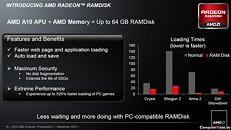- Joined
- Oct 9, 2007
- Messages
- 47,678 (7.43/day)
- Location
- Dublin, Ireland
| System Name | RBMK-1000 |
|---|---|
| Processor | AMD Ryzen 7 5700G |
| Motherboard | Gigabyte B550 AORUS Elite V2 |
| Cooling | DeepCool Gammax L240 V2 |
| Memory | 2x 16GB DDR4-3200 |
| Video Card(s) | Galax RTX 4070 Ti EX |
| Storage | Samsung 990 1TB |
| Display(s) | BenQ 1440p 60 Hz 27-inch |
| Case | Corsair Carbide 100R |
| Audio Device(s) | ASUS SupremeFX S1220A |
| Power Supply | Cooler Master MWE Gold 650W |
| Mouse | ASUS ROG Strix Impact |
| Keyboard | Gamdias Hermes E2 |
| Software | Windows 11 Pro |
AMD's Radeon RAMDisk software, launched along with its desktop A-Series "Trinity" APUs, is being pitched to consumers as a trial software. A combination of A-Series "Trinity" APUs and AMD-certified memory lets you use the software to create a RAMDisk which works in conjuction with the primary HDD/SSD much in the same way as Intel Smart Response tech or NVELO Dataplex, it's just that the cache SSD is replaced by the system memory, an infinitely faster and more durable caching medium. The software juggles data from the primary drive to the RAMDisk based on its heat (frequency of access). Used with DDR3-1600 MHz memory, users could see data access speeds of up to 25.6 GB/s (gigabytes per second), a 1,700-times speedup over conventional HDD. When off the trial, a license to use the software can be bought for $19.

View at TechPowerUp Main Site

View at TechPowerUp Main Site
Last edited by a moderator:








